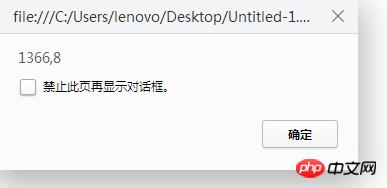- 1PS提示:因为图层已锁定,无法编辑图层的处理方法
- 2picacg苹果版怎么找不到|picacg ios版是不是下架了介绍
- 3Adobe Illustrator CS5 序列号大全
- 4ACDsee注册码免费分享(含ACDsee18、ACDsee10等版本)
- 5PDF浏览器能看3D文件吗?PDF浏览器看3D文件图文详细教程
- 6Potato(马铃薯聊天)怎么注册不了|Potato不能注册处理方法介绍
- 7Potato(土豆聊天)怎么换头像|Potato app更改头像方法介绍
- 8最新的Adobe Illustrator CS4序列号大全
- 9Intel i7-9700K性能跑分曝光:同代提升约12%
- 10qq邮件是否已读怎么看 QQ邮箱已经发出去的邮件怎么知道对方是否已经查看
- 11AMD推土机架构回顾:虽陨落却是Zen成功的垫脚石
- 12美国增加25%进口关税!PC硬件要大涨价
1.getElementsByName():获取name.
~~~~~~~~~~~~~~~~~~~~~~~~~~~~~~~~~~`
例:
<p name="pn">hello</p>
<p name="pn">hello</p>
<p name="pn">hello</p>
<script>
function getName(){
var count=document.getElementsByName("pn");
alert(count.length);
var p=count[2];
p.innerHTML="world";
}
</script>结果:界面打印出三个hello,并且伴有一个提示框“3”,当点击确定后,界面显示的内容变为hello hello world
~~~~~~~~~~~~~~~~~~~~~~~~~~~~~~~~~~~~~~~~~~~~~~~~~··
2.getElementsByTagName():获取元素。
~~~~~~~~~~~~~~~~~~~~~~~~~~~~~
例
<p>hello</p>
<p>hello</p>
<p>hello</p>
<script>
function getName(){
var count=document.getElementsByTagName("p");
alert(count.length);
var p=count[2];
p.innerHTML="world";
}
</script>结果:界面打印出三个hello,并且伴有一个提示框“3”,当点击确定后,界面显示的内容变为hello hello world
~~~~~~~~~~~~~~~~~~~~~~~~~~~~~~~~~~~~~~~~~~~~~~~~~~
3.getAttribute():获取元素属性。
~~~~~~~~~~~~~~~~~~~~~~~~~~~~~~~~~~
例
<a id="aid" title="得到a的标签属性"></a>
<script>
function getAttr1(){
var anode=document.getElementById("aid");
var attr=anode.getAttribute("id");
alert("a的ID是:"+attr);
}
function getAttr2(){
var anode=document.getElementById("aid");
var attr=anode.getAttribute("title");
alert("a的title内容是:"+attr);
}
getAttr1();
getAttr2();
</script>结果:弹出提示框“a的ID是:aid”.点击确定后,弹出提示框“a的title内容是:得到a的标签属性”。
~~~~~~~~~~~~~~~~~~~~~~~~~~~~~~~~~~~
4.setAttribute()设置元素属性。
~~~~~~~~~~~~~~~~~~~~~~~~~~~~~~~~~~~~
例
<a id="aid2">aid2</a>
<script>
function setAttr(){
var anode=document.getElementById("aid2");
anode.setAttribute("title","动态设置a的title属性");
var attr=anode.getAttribute("title");
alert("动态设置的title值为:"+attr);
}
setAttr();
</script>结果:弹出提示框“动态设置的title值为:动态设置a的title属性”。
~~~~~~~~~~~~~~~~~~~~~~~~~~~~
5.childNodes():访问子节点。
~~~~~~~~~~~~~~~~~~~~~~~~~~··
例
<ul><li>1</li><li>2</li><li>3</li></ul>
<script>
function getChildNode(){
var childnode=document.getElementsByTagName("ul")[0].childNodes;
alert(childnode.length);
alert(childnode[0].nodeType);
}
getChildNode();
</script>结果:界面打印出.1 .2 .3弹出对话框“3”,按确定后弹出“1”。
~~~~~~~~~~~~~~~~~~~~~~~~~~~~~~~~~~~~~~~~
6.parentNode():访问父节点。
~~~~~~~~~~~~~~~~~~~~~~~~~~~~~~~~·
例
<p>
<p id="pid"></p>
</p>
<script>
function getParentNode(){
var p=document.getElementById("pid");
alert(p.parentNode.nodeName);
}
getParentNode();
</script>结果:弹出提示框:p.
~~~~~~~~~~~~~~~~~~~~~~~~~~~~~~~~~~
7.createElement():创建元素节点。
~~~~~~~~~~~~~~~~~~~~~~~~~~~~~~~~
例:
<script>
function createNode(){
var body=document.body;
var input=document.createElement("input");
input.type="button";
input.value="按钮";
body.appendChild(input);//插入节点
}
createNode();
</script>结果:出现一个按钮。
~~~~~~~~~~~~~~~~~~~~~~~~~~~
8.createTextNode():创建文本节点。
~~~~~~~~~~~~~~~~~~~~~~~~~~~~~~
例:
<script>
function createNode(){
var element = document.createElement("p");
element.className = "message";
var textNode = document.createTextNode("Hello world!");
element.appendChild(textNode);
document.body.appendChild(element);
}
createNode();
</script>代码分析:这个例子创建了一个新<p>元素并为它指定了值为“message”的class特性。然后,又创建了一个文本节点,并将其添加到前面创建的元素中。最后一步,就是将这个元素添加到了文档中的<body>元素中,这样可以在浏览器中看到新创建的元素和文本节点了。
结果:页面显示hello world。
~~~~~~~~~~~~~~~~~~~~~~~~~~~~~~~~~~~~~~~~~~~
9.insertBefore():插入节点。
~~~~~~~~~~~~~~~~~~~~~~~~~~~~~~~~
例
<p id="p">
<p id="pid">p元素</p>
</p>
<script>
function addNode(){
var p=document.getElementById("p");
var node=document.getElementById("pid");
var newnode=document.createElement("p");
newnode.innerHTML="动态插入一个p元素";
p.insertBefore(newnode,node);
}
addNode();
</script>结果:界面打印出:动态插入一个p元素
p元素
~~~~~~~~~~~~~~~~~~~~~~~~~~~~~~~~~~~~~~~
10.removeChild():删除节点。
~~~~~~~~~~~~~~~~~~~~~~~~~~~~~·
例
<p id="p">
<p id="pid">p元素</p>
</p>
<script>
function removeNode(){
var p=document.getElementById("p");
var p=p.removeChild(p.childNodes[1]);
}
removeNode();
</script>结果:界面什么也没显示。
~~~~~~~~~~~~~~~~~~~~~~~~~~~~~~~~~~~
11.offsetHeight:网页尺寸
12.scrollHeight:网页尺寸
~~~~~~~~~~~~~~~~~~~~~~~~~~~·
例:
<script>
function getSize(){
var width=document.documentElement.offsetWidth document.body.offsetWidth;//解决兼容问题
var height=document.documentElement.offsetHeight document.body.offsetHeight;
alert(width+","+height);
}
getSize();
</script>显示结果:

以上就是本文的全部内容,希望对大家的学习有所帮助,更多相关内容请关注PHP中文网!
相关推荐:
以上就是如何使用JS中DOM来控制HTML元素的详细内容,更多请关注php中文网其它相关文章!
推荐资讯 总人气榜
最新教程 本月人气
- 1腾讯视频会员账号分享(2017年1月4日)
- 2爱奇艺vip会员如何廉价开通?爱奇艺vip会员开通方法
- 3斗鱼TV如何屏蔽礼物?斗鱼TV屏蔽礼物图文说明教程
- 4最新腾讯视频会员账号共享(2017年1月3日)
- 5最新的腾讯视频会员账号免费共享
- 62018年12月29日腾讯视频会员账号共享
- 7腾讯视频周末影院福利开通方法说明
- 82组腾讯视频会员共享(2018.12.28)
- 9腾讯视频如何打开硬件加速?腾讯视频打开硬件加速图文说明教程
- 10腾讯视频下载管理下文在什么地方一个文件夹
- 112017年1月6日更新的腾讯视频会员账号共享账号
- 12a站如何关闭弹幕?AcFun关弹幕图文说明教程
- 1QQ影音如何截取QQ表情?QQ影音截取QQ表情图文说明教程
- 2最新爱奇艺会员账号密码大全(2017.2.20)
- 3QQ影音如何转换视频格式?
- 4qq影音如何慢放与加速?
- 5qq影音如何删除?qq影音删除图文步骤
- 6qq影音如何安装?qq影音安装图文说明教程
- 72组腾讯视频会员共享(2017.02.14)
- 8详细说明MySQL Group Replication[Multi-Primary Mode]的搭建部署过程(图文)
- 9tcl手机750多少钱 tcl750初现手机价格
- 10红米3s如何刷miui8 红米3s刷机miui8方法流程图解
- 11用钱宝如何注销 用钱宝注销图文说明教程详细说明
- 12用钱宝收不到验证码如何回事 用钱宝收不到验证码处理方法

